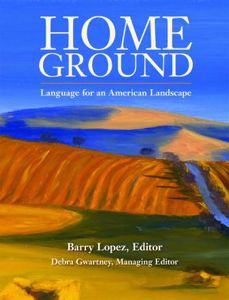The Language of Landscape
Air Date: Week of January 15, 2010

Home Ground: Language for an American Landscape, edited by Barry Lopez and Debra Gwartney. (Courtesy of Trinity University Press)
Living on Earth continues its series exploring features of the American landscape. It’s based on the book “Home Ground: Language for an American Landscape,” edited by Barry Lopez and Debra Gwartney. In this installment, Jan DeBlieu defines the term “pocket beach.”
Transcript
YOUNG: Coming up: the cat called “ghost of the mountain”.
MONTGOMERY: Here is this creature that no on ever sees but it’s able to live in the most extreme habitat in the world at heights that make it so difficult to breathe. They live in temperatures so cold that your tears will freeze on your face and your eyes. And they can become invisible right in front of your eyes.
YOUNG: An expedition in search of the Mongolian Snow Leopard. Just ahead on Living on Earth.
[MUSIC CONTINUES]
YOUNG: It's Living on Earth, I'm Jeff Young.
[HOME GROUND THEME: Daniel Lanois “O Marie” from Acadie (daniellanois.com 2000)]
YOUNG: The problem with being a beach lover is that so many others love beaches, too. But every once in a while the lucky hiker or boater will happen across one to call her own. That’s the subject of our latest excerpt from the book “Home Ground,” a collection of terms to describe our landscape.
Here’s Jan DeBlieu’s definition of a pocket beach.
DEBLIEU: Pocket Beach. A small gem, a pocket beach is a crescent of well-sorted sand tucked into a niche along a coastline. Where is occurs between headlands it is generally hidden from view and so all the more appealing. Pocket beaches are found along the coasts of Maine and Oregon, and in other places where the land falls precipitously into the sea. The term is synonymous with bay head beach and cove beach.
YOUNG: Jan DeBlieu’s most recent book is “Year of the Comet.” She lives on the beautiful beaches of North Carolina’s Outer Banks. The book “Home Ground” was compiled by Barry Lopez and Debra Gwartney.
[MUSIC: Anour Barhem: “Dance With Waves” from The Astounding Eyes Of Rita (ECM Records 2009)]
Links
Living on Earth wants to hear from you!
Living on Earth
62 Calef Highway, Suite 212
Lee, NH 03861
Telephone: 617-287-4121
E-mail: comments@loe.org
Newsletter [Click here]
Donate to Living on Earth!
Living on Earth is an independent media program and relies entirely on contributions from listeners and institutions supporting public service. Please donate now to preserve an independent environmental voice.
NewsletterLiving on Earth offers a weekly delivery of the show's rundown to your mailbox. Sign up for our newsletter today!
 Sailors For The Sea: Be the change you want to sea.
Sailors For The Sea: Be the change you want to sea.
 The Grantham Foundation for the Protection of the Environment: Committed to protecting and improving the health of the global environment.
The Grantham Foundation for the Protection of the Environment: Committed to protecting and improving the health of the global environment.
 Contribute to Living on Earth and receive, as our gift to you, an archival print of one of Mark Seth Lender's extraordinary wildlife photographs. Follow the link to see Mark's current collection of photographs.
Contribute to Living on Earth and receive, as our gift to you, an archival print of one of Mark Seth Lender's extraordinary wildlife photographs. Follow the link to see Mark's current collection of photographs.
 Buy a signed copy of Mark Seth Lender's book Smeagull the Seagull & support Living on Earth
Buy a signed copy of Mark Seth Lender's book Smeagull the Seagull & support Living on Earth

